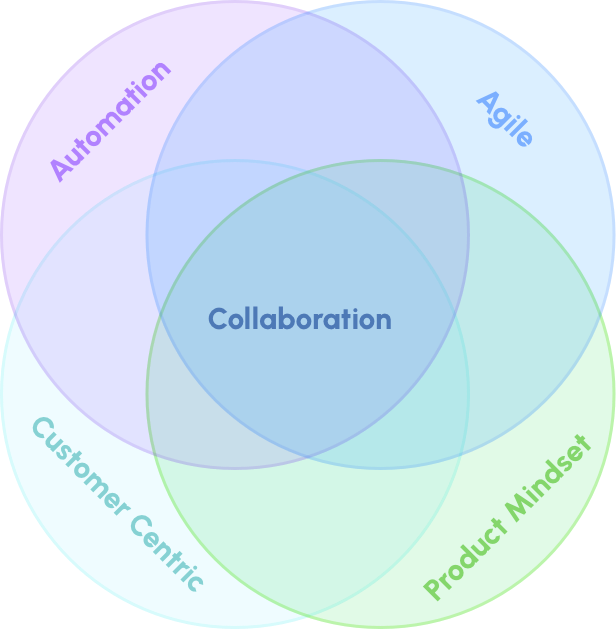A DevOps culture fosters a closer connection between developers and users by deepening tech teams' understanding of user requirements and needs. Operations teams integrate into the development process, contributing maintenance requirements and customer insights. This approach hinges on several key principles that enable DevOps teams to deliver applications and services faster and with higher quality than traditional software development methods.
Theoretical Basis
Conway's Law posits that software systems' architectures closely reflect the organizational structures of the teams that create them. This concept, initially demonstrated with compiler design, applies broadly to various systems. The law underscores how human communication patterns enable and encourage software coupling, where easy communication fosters a deeper understanding and integration of code.
- Melvin Conway
Neglecting Conway's Law can distort system architectures. When a system's design clashes with the development team's structure, module interactions become complex, and potential design benefits are missed due to poor inter-team communication. For smaller teams, informal communication naturally leads to monolithic designs, but larger teams must consider organizational dynamics.
A proactive approach to Conway's Law involves acknowledging its influence. For example, one savvy technical leader structured a system with six subsystems to match the six globally distributed teams, considering the challenges of remote
The problem with Functional Teams
Today's companies are typically structured into functional teams focused on specific areas such as databases, networking, operations, information security, quality assurance, release management, and project management. Project teams are assembled from these specialized silos, with project managers tasked with delivering projects and product managers ensuring the right products are delivered.
The issue with this setup is that functional teams often have little understanding of the broader scope of their contributions. In many cases, these teams are indifferent to the overall IT and business outcomes of the products and services they work on. Their primary concern is to ensure their own areas are protected when projects encounter problems and blame is assigned.
Because functional teams typically handle long queues of support tickets, they require extended lead times to address project needs. Projects vie for these limited resources, leading to frequent escalations, which in turn create a toxic work environment and erode trust among teams.
Consequently, your daily operations are plagued with multiple handovers, delays, quality issues, reworks, bottlenecks, and stress. This is an inherent flaw in matrix organizations, which continue to chase the misleading goal of cost optimization. In reality, due to the quality issues and delays, functional organizations may be more expensive than any other possible reorganization. Additionally, if your company has outsourced vital functions like quality assurance and IT operations to distant locations, your IT organization may struggle to meet critical business demands essential for continuity.
The DevOps Solution
To address the shortcomings of functional teams, DevOps recommends shifting from the misleading goal of cost optimization to the proven benefits of speed optimization. Proper implementation of DevOps not only enhances delivery speed but also reduces costs.
The key principles of DevOps are:
- Collaboration
- Automation
- Agile & Continuous Improvement
- Customer-Centricity
- Product Mindset

Collaboration
The core principle of DevOps is collaboration. Development and operations teams form a cohesive unit that communicates, shares feedback, and collaborates throughout the entire development and deployment process. Often, this involves merging development and operations into a single team that spans the entire application lifecycle.
DevOps team members are accountable for quality deliverables across all product aspects, leading to more comprehensive 'full stack' development. Teams take ownership of a feature or project from inception to delivery, resulting in greater investment and higher quality outcomes.
Automation
In DevOps, automation plays a vital role by optimizing as much of the software development lifecycle as possible. This approach frees developers to focus on coding and creating new features. Automation is integral to a CI/CD pipeline, minimizing human errors and enhancing team productivity. By implementing automated processes, teams can achieve continuous improvement with rapid iteration cycles, enabling swift responses to customer feedback.
Agile & Continuous Improvement
A fundamental principle in agile practices is continuous improvement that focuses on experimentation, and optimizing for speed, cost, and ease of delivery. This concept is intrinsically linked to continuous delivery, allowing DevOps teams to regularly release updates that boost software efficiency. The constant flow of new releases ensures teams consistently implement code changes that reduce waste, enhance development efficiency, and deliver greater value to customers.
Customer-Centricity
DevOps teams use short feedback cycles with customers and end-users to create products and services that meet user needs. DevOps methodologies enable swift collection and response to feedback through real-time monitoring and fast deployments. This approach provides teams with instant insights into user interactions with the software, allowing them to make continuous enhancements.
Product Mindset
"Product-mode" represents a distinct approach to organizing and funding software development, markedly different from traditional project-based methods. This approach is particularly well-suited for enterprises in the digital age, especially those leveraging digital platforms to drive business. Below, we summarize the key distinctions between product-mode and project-mode, which are further elaborated throughout the article.
In an ideal product-mode setup, teams are empowered, outcome-focused, aligned with business capabilities, long-term, and cross-functional. These teams are responsible for ideation, building, and running their products, prioritizing problem-solving and business improvement over meeting predefined scopes and schedules. The challenges these teams tackle are typically ongoing, such as continually improving the conversion rate from cart to checkout (reducing cart abandonment). Problems must be narrowly defined so individual teams can take full ownership. For example, while the "Net Promoter Score" (NPS) is an excellent overall metric, it is often too broad for any single team to manage effectively.
In product-mode, both the team and its focus on a specific problem area are maintained over the long term. These teams frequently adopt a pull-based development approach, emphasizing workflow efficiency over predictability through story-level estimation and release planning.
Conclusion
DevOps recommends forming small teams, each focused on a product, service, or micro-service API that's contributing to improving set of defined KPIs. These teams should be made up of versatile full-stack software engineers who can independently handle every phase of the software development lifecycle, from design to maintenance as well as domain experts of the product that's being built. DevOps utilizes a loosely-coupled service-oriented architecture, where each team is responsible for owning and operating a specific part of the architecture, enhancing integration and efficiency.


